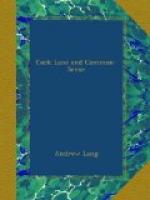This Miraculous Conformist was the younger son of an Irish squire, and a person of some property. After the Restoration—and not before—Greatrakes felt ’a strong and powerful impulse in him to essay’ the art of healing by touching, or stroking. He resisted the impulse, till one of his hands having become ‘dead’ or numb, he healed it by the strokes of the other hand. From that moment Greatrakes practised, and became celebrated; he cured some diseased persons, failed wholly with others, and had partial and temporary success with a third class. The descriptions given by Stubbe, in his letter to the celebrated Robert Boyle, and by Foxcroft, Fellow of King’s College, Cambridge, leave little doubt that ’The Irish Stroker’ was most successful with hypochondriacal and hysterical patients. He used to chase the disease up and down their bodies, if it did not ‘fly out through the interstices of his fingers,’ and if he could drive it into an outlying part, and then forth into the wide world, the patient recovered. So Dr. Stubbe reports the method of Greatrakes. {86} He was brought over from Ireland, at a charge of about 155 pounds, to cure Lady Conway’s headaches. In this it is confessed that he entirely failed; though he wrought a few miracles of healing among rural invalids. To meet this fragrant and miraculous Conformist, Lady Conway invited men worthy of the privilege, such as the Rev. Joseph Glanvill, F.R.S., the author of Sadducismus Triumphatus, his friend Dr. Henry More, the Cambridge Platonist, and other persons interested in mystical studies. Thus at Ragley there was convened the nucleus of an unofficial but active Society for Psychical Research, as that study existed in the seventeenth century.
The object of this chapter is to compare the motives, methods, and results of Lady Conway’s circle, with those of the modern Society for Psychical Research. Both have investigated the reports of abnormal phenomena. Both have collected and published narratives of eye-witnesses. The moderns, however, are much more strict on points of evidence than their predecessors. They are not content to watch, but they introduce ‘tests,’ generally with the most disenchanting results. The old researchers were animated by the desire to establish the tottering faith of the Restoration, which was endangered by the reaction against Puritanism. Among the fruits of Puritanism, and of that frenzied




